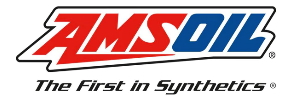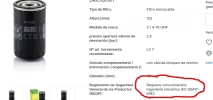Widowmaker
Well-Known Member
Como algunos sabréis, Harley ha utilizado filtros de aceite en sus motores que van desde los 40-30 micrones (tamaño mínimo de la partícula que es capaz de atrapar) hasta los más modernos de 5 micrones. Se tiende a pensar que, cuanto más pequeño, mejor; que el filtrado será más eficiente. Bueno, hay otras cosas a considerar, la más importante es el porcentaje de eficiencia a la hora de filtrar partículas del tamaño referido, porque no es lo mismo un filtro que bloquea el 98% de las partículas de 5 micrones que otro que sólo retiene el 20%. También la superficie total del elemento filtrante, o la presión de apertura de la válvula de bypass.
Os dejo unos apuntes de K&N a propósito de los filtros para HD y la polémica sobre si 5 micrones ó 20:
Hello,
When referring to particle sizes in regards to oil filters, it is important to realize exactly how small the particles being discussed really are. Then, we can discuss the filtration effects of the filters in question in regards to engine life. There is a misconception when it comes to oil filters, that the smaller the micron rating the better the filter. Some companies rate their filter as a “5 micron” filter, which means the filter will catch particles microns in size with at least 50% efficiency. Let’s put a 5 micron particle in perspective. 1 micron is .001mm (or .00003937 inch), so 5 micron is .005mm (.00019685 inch). The tolerances in your engine will be no smaller than 2.5 thousandths of an inch (.0025”). So, 2.5 thousands of an inch which is equal to a 63.5 micron particle. A 5 micron particle is smaller than a human red blood cell, and too small to see with the naked eye. So how can a particle that size cause damage to your engine?
Next, let’s consider the purpose of an oil filter bypass valve. A bypass valve opens when the inlet side of the filter gets too restrictive. This can happen when the engine is cold and the viscosity of the oil is high (due to the weight of the oil), but this primarily happens when the filter media gets too restrictive or clogged. This is done to keep catastrophic engine failure from occurring. The lower the pressure relief rating, the sooner the valve allows oil to bypass the filter. The last factor that contributes to the bypass opening is the amount (surface area) of the filter media used in the filter. A filter that has a high surface area is going to hold more contaminant and promote good oil flow for a longer period of time, so the bypass will take longer to open.
If the filter you use is 95% efficient at 5 microns it is going to remove more contaminant than a filter that is 3% efficient at 5 microns. The question is, how long will it take for those filters to load up with contaminant and enter bypass? The answer is simple, the more efficient filter will load up sooner, but at what expense? Oil flow is necessary to lubricate rotating parts and prevent engine failure, and dirty oil flow is better than starving the engine of oil completely (the theory behind the filter bypass). Clean oil is best for long engine life, and a filter that can promote clean oil flow consistently for a long period of time is a key component of any healthy engine.
When you are talking about filtration, whether it be oil or air, there is a balancing act that has to be performed to ensure your engine gets the protection it needs while giving your engine the most flow possible. Unfortunately, when the focus is an oil filter that is catching extremely small particles at a high percentage, the tradeoff is flow rate. This put the consumer in a “Catch-22” situation. Do you use a filter with the most efficient media at the smallest particle rating, and have the bypass open letting unfiltered oil through the system? Or do you have a filter that does not filter as small a particle size, but filters more of the oil for a longer period of time? K&N filters are designed to give you the balance of oil flow and filtration. Of course, we would like to say we have the most efficient filter at the smallest micron range, but the fact is we are not going to sacrifice oil flow or the quality of filtration by having a high efficiency filter that operates in bypass mode for 80% percent of its life. I know for me personally it’s a simple decision, the small particle filtration does not mean anything to me since we are talking about particles I can’t see, especially if there is a remote possibility of unfiltered oil touching my bearing surfaces causing premature wear and eventual engine failure.
When you are comparing filters, to make the most informed decision possible, look at the following things (with the least amount of emphasis on micron rating): Filtration efficiency, Filter surface area, bypass setting, micron rating.
The KN-171 filter has a nominal micron rating of 25, meaning it will capture 25 micron particles with at least 50% efficiency. The filtration efficiency of the KN-171 at 5 microns is 3%. The KN-171 also has 165 sq.in. of filter area, partially the reason it flows 25% better than the OE, paired with a bypass that opens at 14psi. The equivalent Harley Davidson filter is 95.8% efficient at 5 microns and 98.6% at 25 microns. It also has 63 sq.in. of media and a bypass that opens at 10psi. This means the Harley filter will run in bypass mode for a significant portion of its installed life, whereas the K&N will allow oil to flow through the filter for a longer period of time.
If you have any questions, please contact our Technical Support department.
Thanks for writing,
Thomas Walden
Technical Support & Sports Marketing
800-858-3333
ThomasW@KNFilters.com
Os dejo unos apuntes de K&N a propósito de los filtros para HD y la polémica sobre si 5 micrones ó 20:
Hello,
When referring to particle sizes in regards to oil filters, it is important to realize exactly how small the particles being discussed really are. Then, we can discuss the filtration effects of the filters in question in regards to engine life. There is a misconception when it comes to oil filters, that the smaller the micron rating the better the filter. Some companies rate their filter as a “5 micron” filter, which means the filter will catch particles microns in size with at least 50% efficiency. Let’s put a 5 micron particle in perspective. 1 micron is .001mm (or .00003937 inch), so 5 micron is .005mm (.00019685 inch). The tolerances in your engine will be no smaller than 2.5 thousandths of an inch (.0025”). So, 2.5 thousands of an inch which is equal to a 63.5 micron particle. A 5 micron particle is smaller than a human red blood cell, and too small to see with the naked eye. So how can a particle that size cause damage to your engine?
Next, let’s consider the purpose of an oil filter bypass valve. A bypass valve opens when the inlet side of the filter gets too restrictive. This can happen when the engine is cold and the viscosity of the oil is high (due to the weight of the oil), but this primarily happens when the filter media gets too restrictive or clogged. This is done to keep catastrophic engine failure from occurring. The lower the pressure relief rating, the sooner the valve allows oil to bypass the filter. The last factor that contributes to the bypass opening is the amount (surface area) of the filter media used in the filter. A filter that has a high surface area is going to hold more contaminant and promote good oil flow for a longer period of time, so the bypass will take longer to open.
If the filter you use is 95% efficient at 5 microns it is going to remove more contaminant than a filter that is 3% efficient at 5 microns. The question is, how long will it take for those filters to load up with contaminant and enter bypass? The answer is simple, the more efficient filter will load up sooner, but at what expense? Oil flow is necessary to lubricate rotating parts and prevent engine failure, and dirty oil flow is better than starving the engine of oil completely (the theory behind the filter bypass). Clean oil is best for long engine life, and a filter that can promote clean oil flow consistently for a long period of time is a key component of any healthy engine.
When you are talking about filtration, whether it be oil or air, there is a balancing act that has to be performed to ensure your engine gets the protection it needs while giving your engine the most flow possible. Unfortunately, when the focus is an oil filter that is catching extremely small particles at a high percentage, the tradeoff is flow rate. This put the consumer in a “Catch-22” situation. Do you use a filter with the most efficient media at the smallest particle rating, and have the bypass open letting unfiltered oil through the system? Or do you have a filter that does not filter as small a particle size, but filters more of the oil for a longer period of time? K&N filters are designed to give you the balance of oil flow and filtration. Of course, we would like to say we have the most efficient filter at the smallest micron range, but the fact is we are not going to sacrifice oil flow or the quality of filtration by having a high efficiency filter that operates in bypass mode for 80% percent of its life. I know for me personally it’s a simple decision, the small particle filtration does not mean anything to me since we are talking about particles I can’t see, especially if there is a remote possibility of unfiltered oil touching my bearing surfaces causing premature wear and eventual engine failure.
When you are comparing filters, to make the most informed decision possible, look at the following things (with the least amount of emphasis on micron rating): Filtration efficiency, Filter surface area, bypass setting, micron rating.
The KN-171 filter has a nominal micron rating of 25, meaning it will capture 25 micron particles with at least 50% efficiency. The filtration efficiency of the KN-171 at 5 microns is 3%. The KN-171 also has 165 sq.in. of filter area, partially the reason it flows 25% better than the OE, paired with a bypass that opens at 14psi. The equivalent Harley Davidson filter is 95.8% efficient at 5 microns and 98.6% at 25 microns. It also has 63 sq.in. of media and a bypass that opens at 10psi. This means the Harley filter will run in bypass mode for a significant portion of its installed life, whereas the K&N will allow oil to flow through the filter for a longer period of time.
If you have any questions, please contact our Technical Support department.
Thanks for writing,
Thomas Walden
Technical Support & Sports Marketing
800-858-3333
ThomasW@KNFilters.com






